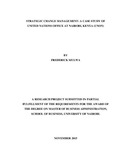| dc.description.abstract | Management of strategic change has become a necessity in modern organizations. This is because organizational health is mirrored in its ability to strategically adapt to global influences on modern business. Globalization and internationalization of modern business requires organizations to develop a global philosophy and approach to business, globally acceptable approaches and technology, techniques and methods, quality standards, processes and products for global customers, global marketing approaches, strategic management practices, global vision of business, globally acceptable political systems to support and facilitate globalization of business and continuous benchmarking with the leading players in the industry. Strategic management has become a global practice for managing strategic change. This is because it enables organizations to be responsive to environmental needs and changes, see competitive challenges in advance, achieve operational effectiveness, develop strategic objectives and actions, effectively mobilize and utilize existing scarce resources and develop effective directional policy. It has become necessary for organizations to continuously adapt their subsystems to enable them meet the requirements of the dynamics in the environment to guarantee their positioning, competitiveness and survival. This is because an organization, as a functional living organism, has to account for its existence by having a mission. Strategic management of change provides this answer. The study sought to establish strategic change management practices at the United Nations Office in Nairobi which, since its inception in 1996, has continued to operate in a constantly changing environment. | en_US |

